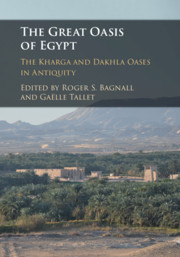Book contents
- The Great Oasis of Egypt
- The Great Oasis of Egypt
- Copyright page
- Contents
- Figures
- Tables
- Contributors
- Preface
- 1 Introduction
- Part I Living in the Oasis: Humans and the Environment
- Part II Managing the Oasis
- Part III Trade and Mobility in a Connected Environment
- 8 The North Kharga Oasis Darb Ain Amur Survey (NKODAAS): Surveying the Tracks between the Two Oases
- 9 And the Potsherds? Some Avenues of Reflection and Synthesis on the Pottery of the Great Oasis
- 10 Egyptian and Imported Amphoras at Amheida
- 11 Kegs from Amheida
- 12 El-Deir as a Switching Point
- Part IV An Oasis Culture?
- Bibliography
- Index of ancient people
- Index of places
- General index
10 - Egyptian and Imported Amphoras at Amheida
from Part III - Trade and Mobility in a Connected Environment
Published online by Cambridge University Press: 12 July 2019
- The Great Oasis of Egypt
- The Great Oasis of Egypt
- Copyright page
- Contents
- Figures
- Tables
- Contributors
- Preface
- 1 Introduction
- Part I Living in the Oasis: Humans and the Environment
- Part II Managing the Oasis
- Part III Trade and Mobility in a Connected Environment
- 8 The North Kharga Oasis Darb Ain Amur Survey (NKODAAS): Surveying the Tracks between the Two Oases
- 9 And the Potsherds? Some Avenues of Reflection and Synthesis on the Pottery of the Great Oasis
- 10 Egyptian and Imported Amphoras at Amheida
- 11 Kegs from Amheida
- 12 El-Deir as a Switching Point
- Part IV An Oasis Culture?
- Bibliography
- Index of ancient people
- Index of places
- General index
Summary
This chapter aims to contribute to the study of the network of commerce between the Great Oasis,the Nile Valley, and the Mediterranean basin during the Roman and Late Roman periods. In particular, it describes the fragments of Egyptian and imported amphoras that have been identified during the course of the analysis of the ceramics from the survey (2012 and 2013) and excavations (2004-13) conducted at Trimithis/Amheida (Dakhla Oasis) by the team sponsored first by Columbia University and then by New York University. The study of these transport containers, which are quite rare in the oases, sheds new light on possible patterns of use and consumption in the different areas of Trimithis, as well as how the polis fits into this range of contacts which interested the oasis during the first to fourth century AD.
- Type
- Chapter
- Information
- The Great Oasis of EgyptThe Kharga and Dakhla Oases in Antiquity, pp. 168 - 191Publisher: Cambridge University PressPrint publication year: 2019

